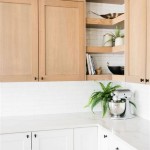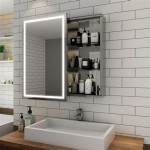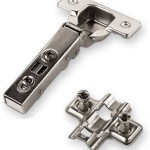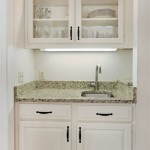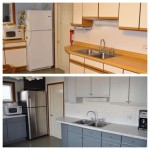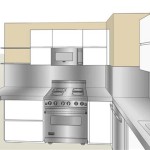How To Fix a Cabinet Door Hinge That Won't Close
A cabinet door that refuses to close properly can be a persistent source of frustration in any home. This seemingly minor issue can lead to damaged cabinet contents, an unkempt appearance, and increased wear and tear on the cabinet frame itself. Understanding the common causes behind this problem and knowing how to diagnose and implement the appropriate repairs can save time, money, and further aggravation. This article provides a detailed guide on troubleshooting and fixing cabinet door hinges that prevent proper closure.
Before embarking on any repair, it is crucial to identify the underlying cause of the problem. Several factors can contribute to a cabinet door hinge failing to function correctly. These include loose screws, misaligned hinges, warped cabinet doors or frames, obstructions within the cabinet, and damaged or worn-out hinges.
Identifying the Root Cause of the Problem
The first step in addressing a malfunctioning cabinet door hinge is a thorough inspection. Begin by visually examining the hinge itself. Look for any signs of damage, such as cracks, bends, or rust. A damaged hinge will likely need to be replaced. Next, assess the screws that secure the hinge to the cabinet frame and the door. Often, these screws will have become loose over time, causing the hinge to shift and preventing the door from closing squarely. Try tightening any loose screws; however, avoid over-tightening, as this can strip the screw holes. Observe the alignment of the hinge plates. Are the plates parallel to each other, or is one skewed in relation to the other? Misalignment is a common culprit, particularly when the cabinet door has been subjected to excessive force or weight.
After inspecting the hinges themselves, examine the cabinet door and frame for any signs of warping. Warping can occur due to changes in humidity or temperature, particularly in areas with poor ventilation. Using a level, check the door and frame to see if they are straight. If warping is present, it may be necessary to adjust the hinges significantly or consider more extensive repairs to the affected wood.
Finally, check for any obstructions inside the cabinet that might be preventing the door from closing properly. Items that are too large or positioned too close to the door can interfere with its movement. Sometimes, even a minor adjustment to the contents of the cabinet is all that is needed to resolve the issue.
Tightening Loose Screws and Addressing Stripped Screw Holes
Loose screws are a frequent cause of cabinet door hinge problems. Over time, the vibrations from opening and closing the door can gradually loosen the screws that hold the hinge in place. This loosening leads to movement in the hinge, preventing the door from aligning correctly and closing smoothly. The initial solution is to simply tighten the loose screws. Use a screwdriver that fits the screw head snugly to avoid stripping the head. Turn the screwdriver clockwise to tighten the screws. Be careful not to overtighten them, as excessive force can damage the screw head or strip the screw hole.
If the screws simply spin without tightening, it indicates that the screw hole has been stripped. A stripped screw hole is a common problem, especially in particleboard or soft wood. Several methods can be used to repair a stripped screw hole. One option is to use wood glue and toothpicks or wooden matchsticks. Break off the toothpicks or matchsticks and insert them into the screw hole, packing it tightly. Apply wood glue to the toothpicks or matchsticks before inserting them to ensure a strong bond. Allow the glue to dry completely, typically for at least 24 hours. Once the glue is dry, trim off any excess toothpick or matchstick material with a knife or chisel. You can then re-drill a pilot hole and re-install the screw. The toothpicks or matchsticks will provide a new, solid surface for the screw to grip.
Another option is to use wood filler or dowels. Wood filler can be used to fill the stripped screw hole and provide a new surface for the screw to grip. Apply the wood filler to the screw hole, ensuring that it is completely filled. Allow the wood filler to dry completely according to the manufacturer's instructions. Once the wood filler is dry, sand it smooth and drill a new pilot hole before re-installing the screw. Dowels, small cylindrical pieces of wood, can also be used to repair stripped screw holes. Drill out the stripped screw hole to a diameter that matches the dowel. Apply wood glue to the dowel and insert it into the hole. Allow the glue to dry completely and then trim off any excess dowel material. Drill a new pilot hole and re-install the screw.
For more persistent stripping, consider using screw hole repair kits. These kits typically include small plastic or metal inserts that are designed to grip the screw more securely. Follow the instructions provided with the kit to install the insert into the stripped screw hole. Once the insert is in place, you can re-install the screw. These kits provide a more robust and long-lasting solution for stripped screw holes.
Adjusting Hinge Alignment for Proper Door Closure
Even if the screws are tightened properly, the cabinet door may still not close correctly if the hinges are misaligned. Most modern cabinet hinges are adjustable, allowing for fine-tuning of the door's position. These adjustments typically involve loosening screws on the hinge and then moving the door slightly before re-tightening the screws. The specific adjustment method will depend on the type of hinge installed.
European-style hinges, also known as concealed hinges, are commonly found in modern cabinets. These hinges typically have multiple adjustment screws that allow for adjustments in three dimensions: horizontal, vertical, and depth. The horizontal adjustment allows you to move the door left or right, the vertical adjustment allows you to move the door up or down, and the depth adjustment allows you to move the door closer to or further from the cabinet frame. To adjust a European-style hinge, first locate the adjustment screws. Loosen the screw slightly, but do not remove it completely. Move the door in the desired direction. Once the door is in the correct position, retighten the screw. Repeat this process for each adjustment screw until the door is properly aligned.
For traditional hinges, which are typically visible on the outside of the cabinet door, the adjustment process may involve loosening the screws that attach the hinge to the cabinet frame and the door. After loosening the screws slightly, gently move the door until it is properly aligned. You may need to use shims, thin pieces of wood or plastic, to fill any gaps between the hinge and the cabinet frame or door. Once the door is aligned correctly, retighten the screws, ensuring that they are snug but not overtightened.
When adjusting hinge alignment, it is essential to work incrementally. Make small adjustments and then check the door's closure to see if the adjustment has improved the situation. It may take several attempts to find the correct position for the door. If you are having difficulty aligning the door, it may be helpful to have someone assist you. One person can hold the door in place while the other tightens the screws.
If the degree of misalignment is significant, it may be necessary to remove the hinge completely and re-install it in a slightly different position. Before removing the hinge, mark its original position on the cabinet frame and door. This will provide a reference point for re-installation. When re-installing the hinge, make sure that it is aligned properly and that the screws are tightened securely. If the screw holes are stripped, use one of the repair methods described above.
In addition to adjusting the hinges, it may also be necessary to adjust the strike plate, which is the metal plate on the cabinet frame that the door latch engages with. If the strike plate is not aligned properly, the door may not latch securely. Loosen the screws that hold the strike plate in place and move it slightly until the door latches properly. Retighten the screws, ensuring that the strike plate is securely attached to the cabinet frame.

How To Adjust Kitchen Cabinet Doors That Won T Close
Easy Fixes How To Fix A Cabinet Door That Won T Close Maxave

Kitchen Cabinet Door Doesn T Stay Open Home Improvement Stack Exchange

How To Fix Door Hinges Cupboard Cabinet Repair

Adjusting Cabinet Hinges The Diy Life

How To Repair Cabinet Door Hinge

How To Adjust A Door That Rubs Doesn T Shut Or Is Sagging

How To Adjust Door Hinges Super Help Advice
Soft Close Hinge Not Working Common Issues And Fixes Maxave

How To Fix Cabinet Door Hinges
Related Posts


